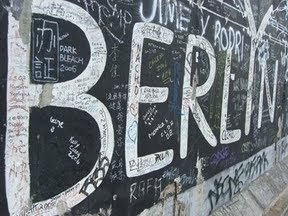Today we saw the Memorial to the Murdered Jews of Europe. (Unfortunately, I was not able to get a picture because I didn't have my iPhone with me. I suggest you look it up online!)
The memorial is a beautiful space with large square pillars that are organized into uniform rows. As one enters the memorial, the pillars gradually get taller until they are well over a visitor's head. The height and scale of the monument itself makes the space overwhelming and powerful. But the blooming trees that punctuate the space (symbolizing hope) are by far the memorial's most shocking and moving features.
In some ways the memorial reminded me of the 9/11 memorial in New York, which features two sunken waterfalls that mark the site of the Twin Towers' foundations. The simplicity and the sheer size of both the Memorial for the Murdered Jews of Europe and the 9/11 Memorial are their most striking similarity. Yet, they both mark the deaths of humans in two distinct ways.
The Berlin memorial marks the decimation of the Jews by filling a space (with grave-like blocks). The memorial in New York, however, commemorates the deaths of the 9/11 victims by removing two sections of the earth. Despite the dissimilarity between the two monuments in terms of their construction, they still create a silent area that facilitates reflection, which older monuments and memorials normally do not accomplish.
In a few days we are going on another tour on "counter monuments" (monuments that document a tragedy rather than a victory or accomplishment). This first tour has only piqued my interest in these types of commemorative spaces and how countries and populations commemorate the loss of life. Expect another blog very soon!

No comments:
Post a Comment